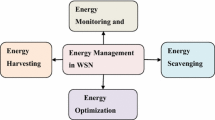Abstract
Wireless sensor networks (WSNs) form a critical component in modern computing applications; given their size, ability to process and communicate information, and to sense stimuli, they are a promising part of the Internet of Things. However, they are also plagued by reliability and node failure problems. Here we address these problems by using the Gene Regulatory Networks (GRNs) of the organism Escherichia coli—believed to be robust against signaling disruptions, such as gene failures—to study the transmission properties of randomly-generated WSNs and transmission structures derived from these genetic networks. Selection of sink nodes is crucial to the performance of these networks; here we introduce four sink-node selection techniques: two motif-based, an attractor based and a highest degree-based approach and perform comprehensive simulations to assess their performance. Specifically, we use NS-2 simulations to evaluate the packet transmission robustness properties of such GRN-derived communication structures as against typical randomly deployed sensor network topologies under varying channel loss models. Packet receipt rates are compared among these networks, which are shown to be higher using GRNs for the communication structure, rather than randomly generated WSNs. We also evaluate the performance of communication structures derived from existing biological network generation models to assess their applicability in providing robust communication. This work paves the way for future development of fault-tolerant and robust WSN deployment and routing algorithms based on the inherent signal transmission robustness properties of the gene regulatory network topologies.

















Similar content being viewed by others
References
Albert R, Barabási A (2002) Statistical mechanics of complex networks. Rev Mod Phys 74:47–97. doi:10.1103/RevModPhys.74.47
Anastasi G et al (2010) Reliability and energy efficiency in multi-hop IEEE 802.15.4/ZigBee wireless sensor networks. In: Proceedings of the The IEEE symposium on Computers and Communications. ISCC 10. IEEE Computer Society, pp 336–341. doi:10.1109/ISCC.2010.5546804
Couto D et al (2003) A high-throughput path metric for multi-hop wireless routing. In: Proceedings of the 9th annual international conference on Mobile computing and networking. MobiCom 03.ACM, pp 134–146. doi:10.1145/938985.939000
Feng J, Jost J, Qian M (2007) Networks: from biology to theory. Springer, Berlin
Fonseca R et al (2007)Four bit wireless link estimation. In: Proceedings of the 6th workshop on hot topics in networks (HotNets). Atlanta, GA
Foundation P.S. (1991) Core Python Programming. http://www.python.org
Genio D, Gross T, Bassler K (2011) All scale-free networks are sparse. Phys Rev Lett 107(17):178701. doi:10.1103/PhysRevLett.107.178701
Ghosh P et al (2011) Principles of genomic robustness inspire fault-tolerant WSN topologies: a network science based case study. In: 2011 IEEE international conference on pervasive computing and communications workshops (PERCOM Workshops), pp 160–165. doi:0.1109/PERCOMW.2011.57668611
Gnawali O et al (2009) Collection tree protocol. In: Proceedings of the 7th ACM conference on embedded networked sensor systems. Berkeley, CA, pp 1–14
Han B, Leblet J, Simon G (2009) Query range problem in wireless sensor network. Commun Lett IEEE 13(1):55–57. doi:10.1109/LCOMM.2009.081546
Ingram P, Stumpf M, Stark J (2006) Network motifs: structure does not determine function. In: BMC genomics 7(1):108. doi: 10.1186/1471-2164-7-108
Kamapantula B et al (2012) Performance of wireless sensor topologies inspired by E. coli genetic networks. In: IEEE international conference on pervasive computing and communications workshops, pp 302–307. doi:http:doi.ieeecomputersociety.org/10.1109/PerComW.2012.6197500
Kauffman S (1969) Metabolic stability and epigenesis in randomly constructed genetic nets. J Theor Biol 22(3):437–467
Kim S, Fonseca R, Culler D (2004) Reliable transfer on wireless sensor networks. In: Proc. of IEEE SECON 2004, pp 449–459
Kitano H (2007) Towards a theory of biological robustness. Mol Sys Biol 3:137–144
Li J, Mohapatra P (2007) Analytical modeling and mitigation techniques for the energy hole problem in sensor networks. Pervasive Mob Comput 3(3):233–254. doi:10.1016/j.pmcj.2006.11.001
Lipshtat A et al (2007) Functions of bifans in context of multiple regulatory motifs in signaling networks. In: eprint: arXiv/0711.4937
Mangan S, Alon U (2003) Structure and function of the feed-forward loop network motif. Proc Natl Acad Sci USA 100(21):11980–11985. doi:10.1073/pnas.2133841100
Mayo M et al (2012) Motif participation by genes in E. coli transcriptional networks. Front Physiol 3:357. doi:10.3389/fphys.2012.00357
McCanne S, Floyd S (1997) Network simulator. University of California, Berkeley
Milo R et al (2002) Network motifs: simple building blocks of complex networks. Science 298(5594):824–827
Prill R, Iglesias P, Levchenko A (2005) Dynamic properties of network motifs contribute to biological network organization. PLoS Biol 3(11):e343. doi:10.1371/journal.pbio.0030343
Schaffter T, Marbach D, Floreano D (2011) GeneNetWeaver: in silico benchmark generation and performance profiling of network inference methods. Bioinformatics 27(5):2263–2270. doi:10.1093/bioinformatics/btr373
Shmulevich I et al (2002) Probabilistic Boolean networks: a rule-based uncertainty model for gene regulatory networks. Bioinformatics 18(2):261–274. doi:10.1093/bioinformatics/18.2.261
Sun Microsystems I (2009) Link Quality Routing Protocol (LQRP). http://www.sunspotworld.com/docs/Red/javadoc/com/sun/spot/peripheral/radio/mhrp/lqrp/package-summary.html
Tiny OS (2009) The MultiHopLQI protocol. http://www.tinyos.net/tinyos-2.x/tos/lib/net/lqi
Vázquez A et al (2004) The topological relationship between the large-scale attributes and local interaction patterns of complex networks. Proc Natl Acad Sci 101(52):17940–17945. doi:10.1073/pnas.0406024101
Wang C et al (2006) A survey of transport protocols for wireless sensor networks. IEEE Netw 20:34–40
Woo A, Tong T, Culler D (2003) Taming the underlying challenges of reliable multihop routing in sensor networks. In: Proceedings of the 1st international conference on embedded networked sensor systems, pp 14–27
Acknowledgments
This work was supported by grant number NSF-1143737, and the US Army’s Environmental Quality and Installations 6.1 basic research program. The Chief of Engineers approved this material for publication.
Author information
Authors and Affiliations
Corresponding author
Rights and permissions
About this article
Cite this article
Kamapantula, B.K., Abdelzaher, A., Ghosh, P. et al. Leveraging the robustness of genetic networks: a case study on bio-inspired wireless sensor network topologies. J Ambient Intell Human Comput 5, 323–339 (2014). https://doi.org/10.1007/s12652-013-0180-0
Received:
Accepted:
Published:
Issue Date:
DOI: https://doi.org/10.1007/s12652-013-0180-0




